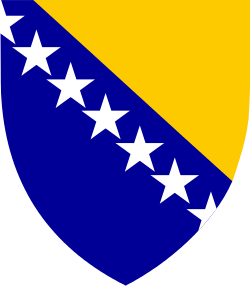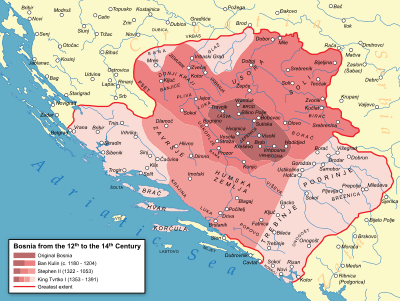Bosnia and Herzegovina in the Middle Ages
Part of a series on the |
|---|
| History of Bosnia and Herzegovina |
 |
|
Ottoman era |
|
Habsburgs |
|
|
This is the history of Bosnia and Herzegovina in the Middle Ages, between the ancient and Roman period and the Ottoman period.
Early Middle Ages
The western Balkans had been reconquered from "barbarians" by Byzantine Emperor Justinian (r. 527–565). Sclaveni raided the western Balkans, including Bosnia, in the 6th century.[1] Slavs settled throughout the Balkans, scholarship maintaining that a second wave was invited by Emperor Heraclius to drive the Avars from Dalmatia.[2] In the Early Middle Ages, the bulk of Bosnia proper was a territory between Serb and Croat rule.[3] Bosnia is first mentioned as a land (horion Bosona) in Byzantine Emperor Constantine Porphyrogenitus' De Administrando Imperio in the mid 10th century, at the end of a chapter (Chap. 32) entitled "Of the Serbs and the country in which they now dwell".[4] This has been scholarly interpreted in several ways and used especially by the Serb national ideologists to prove Bosnia as originally a "Serb" land. Other scholars have asserted the inclusion of Bosnia into Chapter 32 to merely be the result of Serbian Grand Duke Časlav's temporary rule over Bosnia at the time, while also pointing out that Porphyrogenitus does not say anywhere explicitly that Bosnia is a "Serb land".[5] In fact, the very translation of the critical sentence in which the word Bosona (Bosnia) appears is subject to varying interpretation.[4] Bosnia at that time was located around the river Bosna in the modern-day fields of Sarajevo and of Visoko.[6][7] This area had previously been the land of the Daesitiates.[8] It included two inhabited cities according to DAI, "Katera" (later Vrhbosna) and "Desnik" (unclear).[7][6] The Byzantines restored control in the area at the end of the 10th century, while Bulgaria had a short-lived overlordship until 1019 when Basil II restored control.
High Middle Ages
Duklja and Hungary
In time, Bosnia became separated under its own ruler.[3] Bosnia, along with other territories, became part of Duklja in the 11th century, although it retained its own nobility and institutions.[9] Constantine Bodin placed his relative, Stephen, as governor of Bosnia. After Bodin's death in 1101, discords erupted, and by the end of the 12th century, Bosnia would find itself completely detached from Duklja. Some attempts to reunite Bosnia and Duklja were made, especially by king Kočopar (1102–1103) of Duklja who forged an alliance with Bosnia against Rascia and Zahumlje, but utterly failed with his death.[10]
After Croatia entered personal union with Hungarian kingdom in 1102, most of Bosnia became vassal to Hungary as well. Since 1137, King Bela II of Hungary claimed the Duchy of Rama, a region of northern Herzegovina. His title included "rex Ramae" since the Council at Ostrogon 1138, likely referring to all of Bosnia. However, by the 1160s the Byzantine Emperor Manuel I Comnenus defeated Hungary and restored Bosnia to the Eastern Roman Empire for a time.
Banate
With Croatia acquired by the Hungarian Kingdom, and the Serbian state in a period of stagnation, control over Bosnia was subsequently contested between the Kingdom of Hungary and the Byzantine empire. In 1154, Hungary appointed Ban Borić as the first ruler and Viceroy of Bosnia. Under the pressure of the Byzantine, a subsequent King of Hungary appointed one Kulin as a Ban to rule the province under the eastern vassalage. However, this vassalage was largely nominal.
The second Bosnian ruler, Ban Kulin, allegedly presided over nearly three decades of peace and stability during which he strengthened the country's economy through treaties with Dubrovnik and Venice. His rule also marked the start of a controversy with the Bosnian Church, an indigenous Christian sect considered heretical by both the Roman Catholic and Eastern Orthodox churches. In response to Hungarian attempts to use church politics regarding the issue as a way to reclaim sovereignty over Bosnia, Kulin held a council of local church leaders to renounce the heresy in 1203. Despite this, Hungarian ambitions remained unchanged long after Kulin's death in 1204, waning only after an unsuccessful invasion in 1254.

Late Middle Ages
Kingdom of Bosnia
Bosnian history from then until the early 14th century was marked by the power struggle between the Šubić and Kotromanić families. This conflict came to an end in 1322, when Stjepan II Kotromanić became ban. By the time of his death in 1353, he had succeeded in annexing territories to the north and west, as well as Zahumlje and parts of Dalmatia. He was succeeded by his nephew Tvrtko who, following a prolonged struggle with nobility and inter-family strife, gained full control of the country in 1367. Under Tvrtko, Bosnia grew in both size and power, finally becoming an independent kingdom in 1377. Following his death in 1391 however, Bosnia fell into a long period of decline.
The Ottoman Empire had already started its conquest of Europe and posed a major threat to the Balkans throughout the first half of the 15th century. Finally, after decades of political and social instability, Bosnia officially fell in 1463, while resistance was active and fierce for a few more centuries. Southern regions of Bosnia, nowadays known as "Herzegovina" would follow in 1483, with a Hungarian-backed reinstated Bosnian kingdom being the last to succumb in 1527.
Medieval sites
Fortifications
- Blagaj Fort, 10th–15th c.
- Bobovac, 14th–15th c.
- Borač, 15th c.
- Bužim Fort, 12th–15th c.
- Doboj Fortress, 13th–15th c.
- Glamoč Fortress, 14th c.–?
- Hodidjed, –15th c.
- Jajce Fortress, 14th c.–?
- Komotin Fort, 14th c.–?
- Maglaj Fortress, 14th c.–?
- Visoko, 14th c.–1503
- Srebrenik Fortress, 14th c.–?
- Zvornik Fortress, 13th c.–?
Religious buildings
Places of worship built before Ottoman conquest of medieval Bosnian Kingdom and abolition of the state in 1463.
Orthodox
Catholic
Islamic
See also
References
- ↑ Fine 1991, p. 32.
- ↑ Malcolm 2002.
- 1 2 Fine 1991, p. 53.
- 1 2 Basic 2009, p. 123.
- ↑ Basic 2009, p. 123-28.
- 1 2 Mrgić 2004.
- 1 2 Vladimir Ćorović, Teritorijalni razvoj bosanske države u srednjem vijeku, Glas SKA 167, Belgrade, 1935, pp. 10-13
- ↑ Ivan Mužić (December 2010). "Bijeli Hrvati u banskoj Hrvatskoj i županijska Hrvatska". Starohrvatska prosvjeta (in Croatian). Split, Croatia: Museum of Croatian Archaeological Monuments. III (37): 270. ISSN 0351-4536. Retrieved 2012-09-12.
Bosna u obujmu, u kakvom se navodi u djelu DAI kao jedinstvena teritorijalna jedinica, protezala se, kako neki autori smatraju, na području u kojem su prije prebivali Desitijati (M. Hadžijahić). Ti Desitijati, koji su nastavali istočnu i srednju Bosnu počevši od Travnika prema Rogatici pa dalje, imali su središte oko današnje Breze. (Mandić 1942, str. 133.)
- ↑ Fine 1991, p. 223.
- ↑ Vladimir Corovic: Istorija srpskog naroda
Sources
- Basic, Denis (2009). "4.1.1. Early Medieval Bosnia in Porphyrogenitus' De Administrando Imperio". The Roots of the Religious, Ethnic, and National Identity of the Bosnian-Herzegovinian Muslims. University of Washington.
- Bataković, Dušan T. (1996). The Serbs of Bosnia & Herzegovina: History and Politics. Dialogue Association.
- Constantine VII Porphyrogenitus (1993). De Administrando Imperio (Moravcsik, Gyula ed.). Washington D.C.: Dumbarton Oaks Center for Byzantine Studies.
- Fine, John Van Antwerp, Jr. (1991). The Early Medieval Balkans: A Critical Survey from the Sixth to the Late Twelfth Century. University of Michigan Press. ISBN 978-0-472-08149-3.
- Fine, John Van Antwerp, Jr. (1994). The Late Medieval Balkans: A Critical Survey from the Late Twelfth Century to the Ottoman Conquest. University of Michigan Press. ISBN 9780472082605.
- Malcolm, Noel (2002). Bosnia: A Short History. Pan Books. ISBN 978-0-330-41244-5.
- Mrgić, Jelena (2004). "Rethinking the territorial development of the medieval Bosnian state". Historical Review. Serbian Academy of Sciences and Arts - Institute of History. LI: 46–53. ISSN 0350-0802. Retrieved 2012-09-12.
- Vego, Marko (1982). Postanak srednjovjekovne bosanske države. Svjetlost.
External links
| Wikimedia Commons has media related to Middle Ages in Bosnia and Herzegovina. |